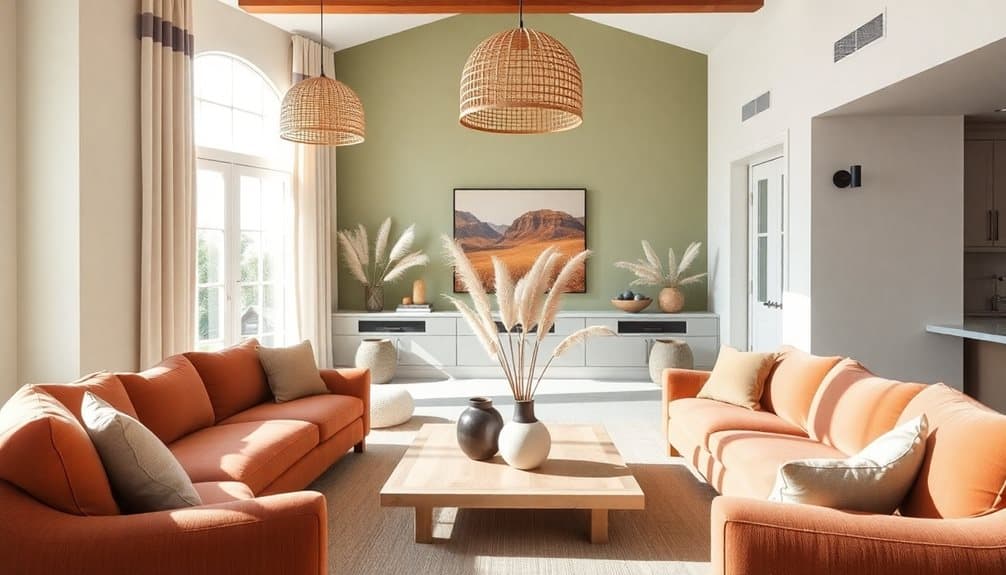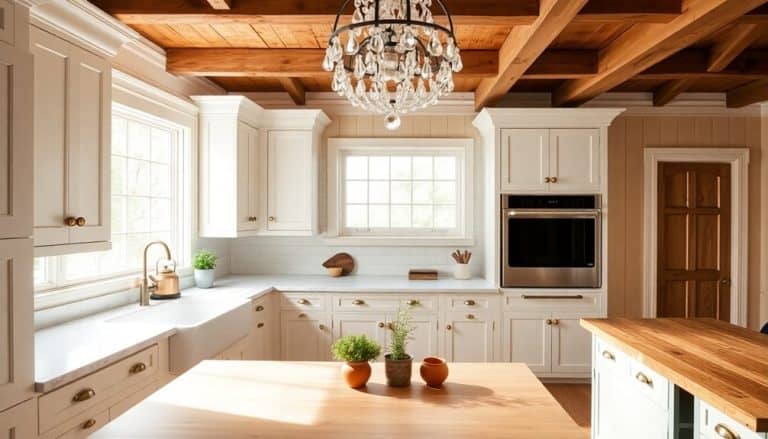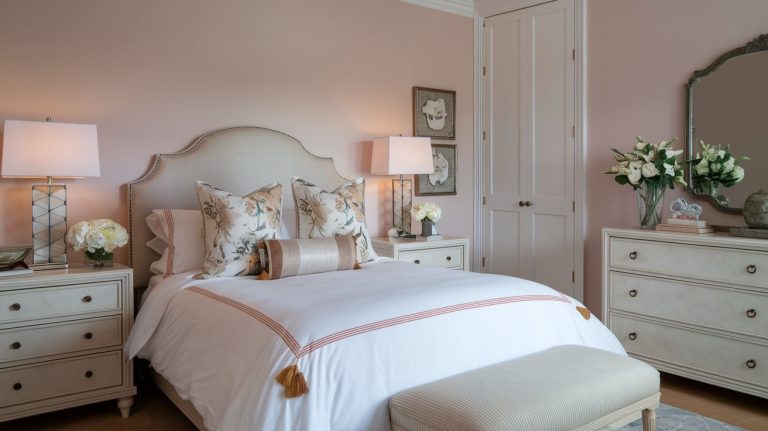This website contains affiliate links. Some products are gifted by the brand to test. As an Amazon Associate, I earn from qualifying purchases. The content on this website was created with the help of AI.
You’ll find 2024’s most popular home decorating styles focusing on smart integration and sustainable luxury. Digital minimalism leads the way, with invisible tech seamlessly blending into your space through smart surfaces and AI-powered features. Biophilic elements bring the outdoors in, incorporating living walls and nature-inspired materials for a sophisticated sanctuary feel. Multifunctional spaces adapt to your needs with modular furniture and smart partitions, while eco-conscious designs privilege sustainable materials and energy efficiency. Wellness-centered innovations, like circadian lighting and air quality management, transform your home into a health-optimizing haven. Let’s explore how these elements work together to create your ideal space.
Key Takeaways
- Smart-Integrated Modern combines invisible technology with clean aesthetics, featuring voice-activated systems and transformative wall displays.
- Biophilic Luxury merges natural elements with high-end finishes, incorporating living walls and nature-inspired colors like emerald and mahogany.
- Sustainable Minimalism emphasizes eco-friendly materials, zero-VOC finishes, and multifunctional furniture made from reclaimed or recycled resources.
- Wellness-Focused Design prioritizes circadian lighting, air quality management systems, and sound-absorbing materials for optimal living environments.
- Adaptive Contemporary features modular furniture systems and smart partitions that transform spaces for multiple uses throughout the day.
Digital Minimalism Meets Modern Living

In 2024, digital minimalism has evolved beyond mere decluttering to embrace a sophisticated fusion of technology and simplicity. You’ll find smart surfaces that double as hidden displays, with walls transforming into screens only when needed. The key is integrating tech seamlessly while maintaining clean lines and uncluttered spaces.
Your furniture choices should prioritize multifunctional pieces with built-in charging capabilities and wireless connectivity. Think modular sofas with integrated speakers that disappear into sleek, neutral-toned upholstery. Clear surfaces dominate, with storage solutions utilizing AI-powered organization systems that keep essentials hidden yet accessible.
The color palette centers on warm grays, soft whites, and muted earth tones, creating a calm backdrop for your digital interfaces. You’ll want to incorporate smart glass windows that adjust transparency automatically and voice-activated lighting systems that blend invisibly into architectural elements. Natural materials like bamboo and recycled composites complement the tech-forward elements, while minimalist art pieces feature subtle interactive capabilities. The goal isn’t to eliminate technology but to make it virtually invisible until it’s needed, allowing you to maintain a serene, uncluttered environment that responds intuitively to your needs. Consider incorporating space-saving designs that can compress or expand based on your changing needs, similar to modern storage solutions.
Biophilic Luxury and Natural Elements
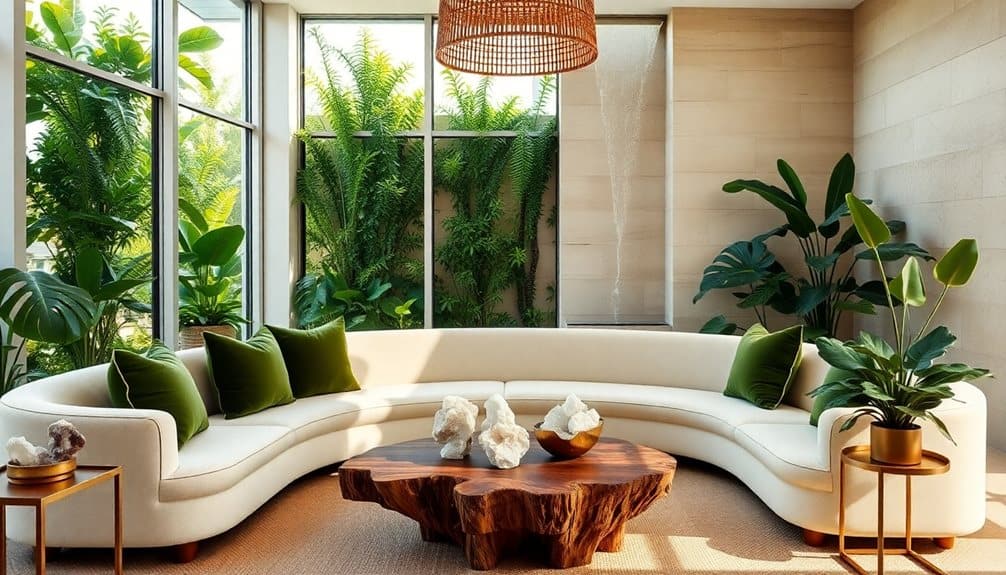
Nature enthusiasts are elevating biophilic design to new heights in 2024, merging raw organic elements with opulent finishes. You’ll find living walls draped with rare tropical plants alongside marble surfaces, while handcrafted wooden furniture pairs with gold-leafed accents. This luxe-meets-nature approach transforms everyday spaces into sophisticated sanctuaries.
To achieve this look, you’ll want to incorporate premium natural materials like quartzite countertops, teak wood panels, and hand-knotted wool rugs. Smart skylights that adjust to natural circadian rhythms work alongside curved architectural elements that mirror organic shapes. You can enhance your space with water features crafted from sustainable materials, such as recycled glass fountains or bamboo water walls.
The color palette draws directly from nature’s most luxurious offerings – think deep emerald, rich mahogany, and shimmering pearl. Don’t shy away from statement pieces like oversized crystal geodes or preserved moss art installations. Layer in textural elements using raw silk curtains, petrified wood side tables, and hand-carved stone basins. The key is balancing untamed natural beauty with refined, purposeful luxury that engages all your senses. Transform your space with stylish decor finds that complement your biophilic design choices while maintaining visual harmony.
Adaptive Multifunctional Spaces
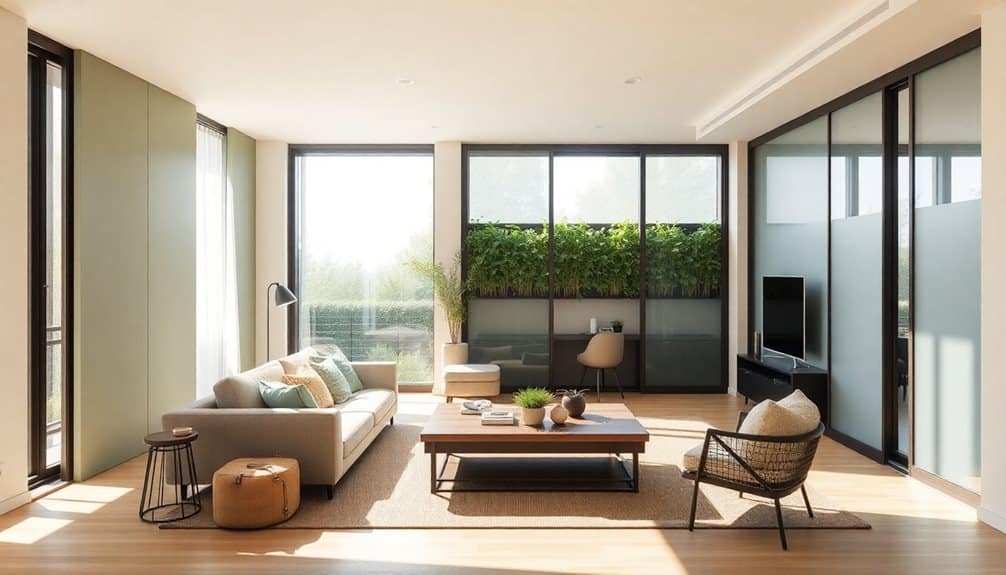
While home layouts once rigidly defined each room’s purpose, 2024’s most influential spaces adapt seamlessly to your changing needs throughout the day. You’ll find modular furniture systems that transform from workspace to dining area in minutes, with built-in storage that slides and pivots to create new configurations. Smart partitions rise from the floor or descend from the ceiling at the touch of a button, instantly dividing open-plan areas into private zones.
The key to successful adaptive spaces lies in selecting versatile pieces that serve multiple functions. Consider murphy beds with integrated desks, ottomans that unfold into guest beds, and height-adjustable tables that shift from coffee table to work surface. Today’s popular designs incorporate charging stations and connectivity ports within furniture pieces, while automated lighting systems adjust to each space’s current function.
You’ll want to invest in lightweight, mobile furniture on castors for easy reconfiguration, and opt for compact pieces that nest or stack when not in use. The most sought-after designs feature built-in technology that remembers your preferred layouts and automatically adjusts room elements to suit different activities throughout your day. Much like innovative fastening systems in modern greenhouse construction, these adaptable living spaces prioritize quick and efficient transitions between different configurations.
Eco-Conscious Design Solutions
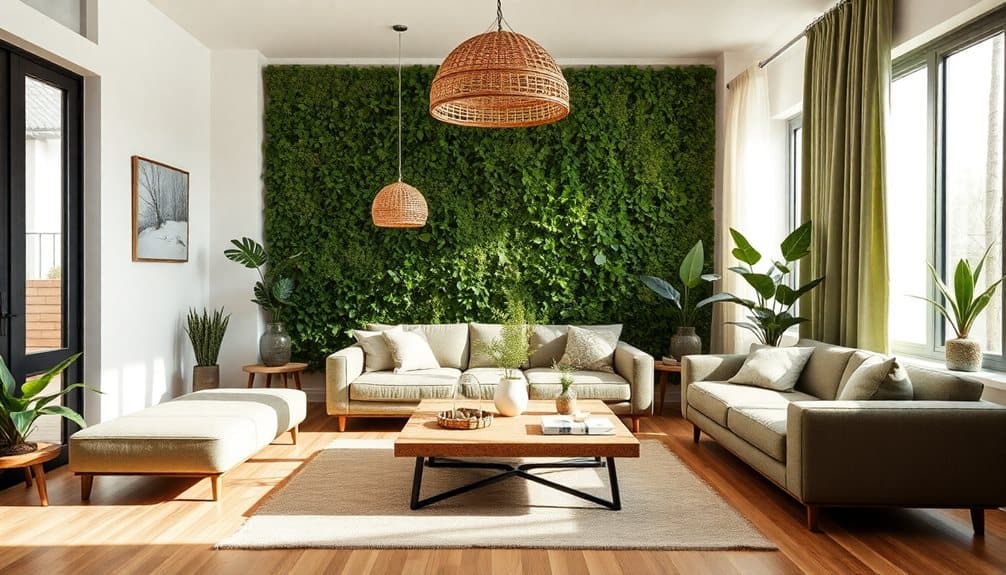
Modern homeowners are revolutionizing their spaces with eco-conscious design choices that complement their adaptable environments. You’ll find reclaimed wood furniture, living walls, and renewable bamboo flooring taking center stage in 2024’s most stylish homes. These sustainable elements aren’t just trendy – they’re essential components of responsible design that reduce your carbon footprint while creating stunning visual impact. For a natural growing medium in your living walls, coco coir products provide an eco-friendly alternative to traditional soil that helps retain moisture and promote healthy plant growth.
- Install energy-efficient smart windows that automatically adjust their tint based on sunlight intensity, cutting your cooling costs by up to 40% while protecting your interior from UV damage
- Choose biophilic materials like cork flooring, hemp textiles, and mycelium-based decorative panels that naturally purify indoor air and bring organic textures into your space
- Integrate water-conservation systems through decorative rain chains and artistic greywater features that double as sculptural centerpieces
The key to mastering eco-conscious design lies in selecting materials that serve multiple purposes. You’ll want to focus on pieces that combine sustainability with functionality, like solar-powered pendant lights made from recycled glass or modular furniture crafted from ocean-bound plastics. These elements create a sophisticated aesthetic while supporting environmental preservation.
Smart Home Integration

In accordance with emerging design trends, smart home integration has evolved beyond basic automation into seamlessly woven digital ecosystems. You’ll find that today’s smart homes prioritize invisible tech, with screens that double as artwork and charging surfaces disguised within furniture. Voice-activated systems now respond to context and mood, adjusting lighting, temperature, and ambient sounds without visible interfaces.
The latest smart home features include AI-powered windows that automatically tint based on sunlight patterns, and walls with embedded circuitry that respond to touch. You’ll notice that decorative elements like mirrors now serve multiple functions, displaying weather updates, schedules, and news while maintaining their aesthetic appeal. Multi-sensory integration allows your space to adapt throughout the day, from energizing morning settings to calming evening atmospheres.
For the most current look, you’ll want to incorporate smart textiles that change color on demand and furniture with built-in environmental sensors. The key is selecting pieces that enhance your daily routine while maintaining a sophisticated appearance. Remember that successful smart home integration in 2024 means technology should be felt rather than seen.
Wellness-Centered Interior Design
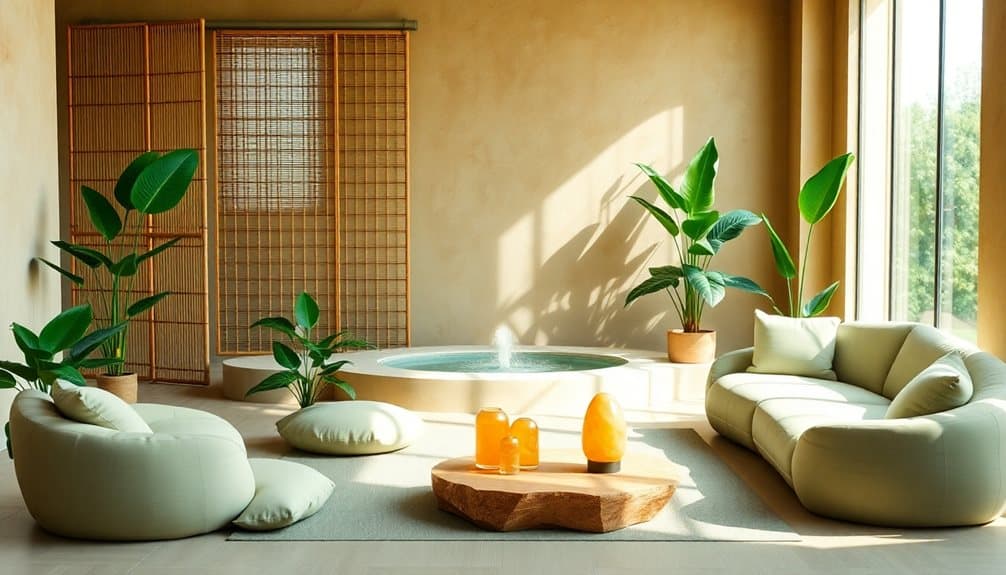
Wellness-centered design has emerged as a cornerstone of 2024’s most coveted interiors, blending biophilic elements with science-backed features that enhance mental and physical health. You’ll find circadian lighting systems that automatically adjust throughout the day, supporting your natural sleep-wake cycle while reducing eye strain and boosting productivity.
Air purification has taken center stage, with built-in systems that monitor and cleanse indoor air quality in real-time. You’re now able to track pollutant levels, humidity, and air composition through your smartphone, ensuring ideal breathing conditions at all times.
- Living walls and indoor gardens aren’t just aesthetic choices—they’re integrated oxygen generators that double as natural humidifiers and stress reducers
- Sound-absorbing materials and acoustic panels have evolved to include frequency-specific technologies that block harmful noise while allowing beneficial sounds to pass through
- Zero-VOC materials and antimicrobial surfaces have become standard, featuring self-cleaning properties that maintain a hygienic environment without harsh chemicals
The focus has shifted from purely visual appeal to creating spaces that actively contribute to your physical and mental wellbeing, making wellness-centered design a non-negotiable aspect of modern interiors.
Frequently Asked Questions
How Much Does It Typically Cost to Renovate a Home in These Styles?
You’ll need to budget $30,000-$75,000 for a complete style renovation, depending on your home’s size and chosen finishes. Modern minimalist designs typically cost less, around $25,000-$45,000, while luxury organic-modern renovations can reach $100,000+. Don’t forget to factor in high-end sustainable materials at $100-300 per square foot, smart home integration at $5,000-$15,000, and professional design fees averaging 10% of your total budget.
Which Decorating Styles Work Best for Small Apartments Under 500 Square Feet?
Did you know that 82% of small-space dwellers report feeling more content when using minimalist and multifunctional designs? For your sub-500-square-foot apartment, you’ll thrive with Scandinavian minimalism, featuring light colors and clean lines. Japanese Zen style works wonders too, incorporating sliding doors and built-in storage. Don’t overlook modern industrial with its space-saving loft solutions and vertical storage options.
Where Can I Find Affordable Furniture That Matches These Popular Design Trends?
You’ll find stylish yet budget-friendly furniture at online retailers like Wayfair, AllModern, and Overstock, which regularly offer sales and free shipping. Don’t overlook Facebook Marketplace and local thrift stores for unique vintage pieces that fit current trends. Target’s Project 62 and IKEA’s collections consistently deliver affordable modern designs, while Amazon’s private labels like Rivet and Stone & Beam offer trendy pieces at competitive prices.
How Long Do These Interior Design Trends Usually Stay in Fashion?
You’d be surprised to learn that even in this Tesla-powered era, interior design trends typically cycle every 3-5 years, though some classic elements endure for decades. You’ll notice that major style shifts, like minimalism or maximalism, can dominate for up to 10 years. What’s fascinating is how social media has accelerated these cycles, with micro-trends now emerging and fading within 12-18 months.
What Are the Best Paint Colors to Complement These Decorating Styles?
You’ll find that earthy neutrals like sage green, warm taupe, and clay tones work wonderfully with today’s popular design aesthetics. For a modern look, try deep charcoal or crisp white as your base. If you’re embracing biophilic design, opt for nature-inspired blues and greens. Don’t shy away from rich terracotta or muted gold accents – they’ll add warmth while staying current with contemporary trends.

